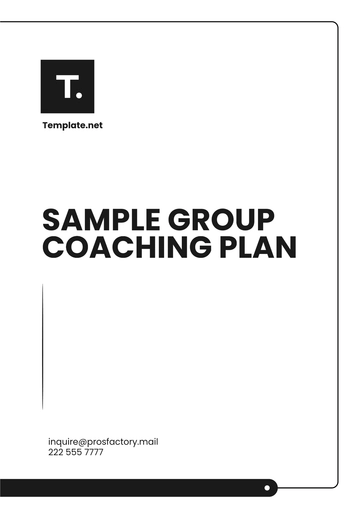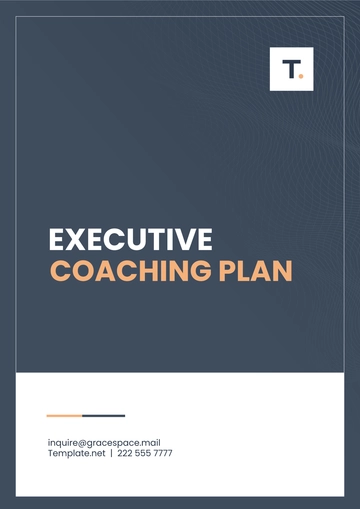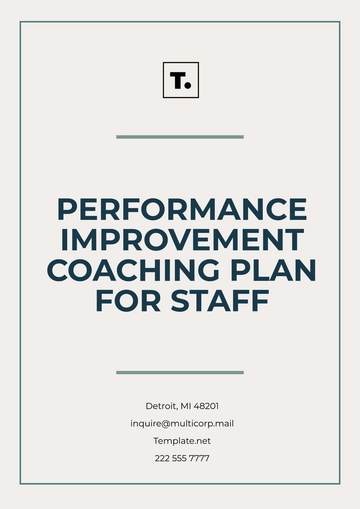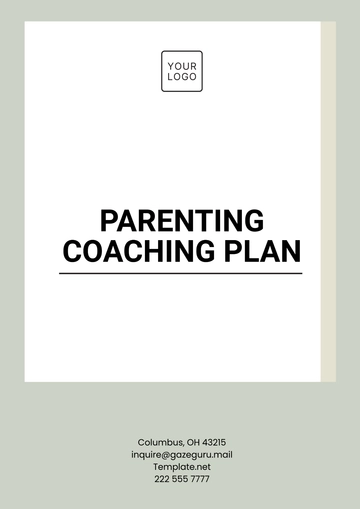Free Executive Coaching Plan

I. Introduction and Overview
This executive coaching plan is designed to support [Your Name], a Vice President of Marketing at [Your Company Name], in enhancing their leadership skills, strategic thinking, and overall effectiveness in their role. The coaching engagement will focus on achieving specific goals that align with both personal development and organizational objectives.
II. Coaching Goals
The following goals have been identified for this coaching engagement:
Goal 1: Improve Decision-Making Skills
Enhance the ability to make data-driven and timely decisions in high-pressure situations.Goal 2: Strengthen Leadership Presence
Develop stronger interpersonal communication and executive presence when leading teams and managing key stakeholders.Goal 3: Increase Emotional Intelligence
Enhance self-awareness and empathy to improve interactions with team members and foster a positive work environment.
III. Assessment and Feedback
The following assessments will be used to gather initial insights and baseline measurements of the executive’s current performance:
360-Degree Feedback
Collect feedback from peers, direct reports, and supervisors to identify areas for improvement.Leadership Competency Assessment
Evaluate strengths and weaknesses across key leadership competencies such as strategic thinking, emotional intelligence, and communication.Self-Reflection and Self-Assessment
Encourage the executive to assess their own strengths, challenges, and development areas through structured self-reflection exercises.
IV. Action Plan
The action plan outlines specific steps and strategies for achieving the set goals:
A. Improving Decision-Making Skills
Participate in decision-making simulations and case studies.
Attend workshops on critical thinking and decision-making frameworks.
Apply decision-making techniques to current work scenarios, followed by feedback sessions.
B. Strengthening Leadership Presence
Engage in public speaking and presentation training.
Observe and analyze successful leaders within and outside the organization.
Regularly practice leadership communication with team members.
C. Increasing Emotional Intelligence
Complete an emotional intelligence training program.
Practice active listening and empathy in everyday interactions.
Set regular feedback sessions with a mentor or coach to track progress.
V. Timeline
The coaching program will be conducted over six months, with the following schedule:
Month 1-2: Initial assessments and identification of key goals. Begin action steps for improving decision-making and leadership presence.
Month 3-4: Continue with action steps, introduce emotional intelligence training, and adjust goals as necessary.
Month 5-6: Focus on refining leadership presence and emotional intelligence. Conduct follow-up assessments to measure progress and adjust the action plan.
VI. Evaluation and Metrics
To measure progress and evaluate the effectiveness of the coaching plan, the following metrics will be used:
Progress Toward Goals: Evaluate whether the goals set at the beginning of the coaching plan have been achieved, using both qualitative feedback and quantitative measures.
360-Degree Feedback Reassessment: Reassess the feedback from peers, subordinates, and supervisors to gauge improvement in leadership competencies.
Self-Reflection: The executive will regularly reflect on their progress through journaling or self-assessments.
Coaching Session Feedback: Collect feedback from each coaching session to ensure continuous improvement and relevance of the coaching strategy.
- 100% Customizable, free editor
- Access 1 Million+ Templates, photo’s & graphics
- Download or share as a template
- Click and replace photos, graphics, text, backgrounds
- Resize, crop, AI write & more
- Access advanced editor
Elevate the leadership of high-level executives with the Executive Coaching Plan Template from Template.net. This editable and customizable template is designed for professionals looking to sharpen their leadership abilities. Whether it’s enhancing strategic thinking or improving communication, the Ai Editor Tool allows you to tailor the plan to meet specific executive needs.
You may also like
- Finance Plan
- Construction Plan
- Sales Plan
- Development Plan
- Career Plan
- Budget Plan
- HR Plan
- Education Plan
- Transition Plan
- Work Plan
- Training Plan
- Communication Plan
- Operation Plan
- Health And Safety Plan
- Strategy Plan
- Professional Development Plan
- Advertising Plan
- Risk Management Plan
- Restaurant Plan
- School Plan
- Nursing Home Patient Care Plan
- Nursing Care Plan
- Plan Event
- Startup Plan
- Social Media Plan
- Staffing Plan
- Annual Plan
- Content Plan
- Payment Plan
- Implementation Plan
- Hotel Plan
- Workout Plan
- Accounting Plan
- Campaign Plan
- Essay Plan
- 30 60 90 Day Plan
- Research Plan
- Recruitment Plan
- 90 Day Plan
- Quarterly Plan
- Emergency Plan
- 5 Year Plan
- Gym Plan
- Personal Plan
- IT and Software Plan
- Treatment Plan
- Real Estate Plan
- Law Firm Plan
- Healthcare Plan
- Improvement Plan
- Media Plan
- 5 Year Business Plan
- Learning Plan
- Marketing Campaign Plan
- Travel Agency Plan
- Cleaning Services Plan
- Interior Design Plan
- Performance Plan
- PR Plan
- Birth Plan
- Life Plan
- SEO Plan
- Disaster Recovery Plan
- Continuity Plan
- Launch Plan
- Legal Plan
- Behavior Plan
- Performance Improvement Plan
- Salon Plan
- Security Plan
- Security Management Plan
- Employee Development Plan
- Quality Plan
- Service Improvement Plan
- Growth Plan
- Incident Response Plan
- Basketball Plan
- Emergency Action Plan
- Product Launch Plan
- Spa Plan
- Employee Training Plan
- Data Analysis Plan
- Employee Action Plan
- Territory Plan
- Audit Plan
- Classroom Plan
- Activity Plan
- Parenting Plan
- Care Plan
- Project Execution Plan
- Exercise Plan
- Internship Plan
- Software Development Plan
- Continuous Improvement Plan
- Leave Plan
- 90 Day Sales Plan
- Advertising Agency Plan
- Employee Transition Plan
- Smart Action Plan
- Workplace Safety Plan
- Behavior Change Plan
- Contingency Plan
- Continuity of Operations Plan
- Health Plan
- Quality Control Plan
- Self Plan
- Sports Development Plan
- Change Management Plan
- Ecommerce Plan
- Personal Financial Plan
- Process Improvement Plan
- 30-60-90 Day Sales Plan
- Crisis Management Plan
- Engagement Plan
- Execution Plan
- Pandemic Plan
- Quality Assurance Plan
- Service Continuity Plan
- Agile Project Plan
- Fundraising Plan
- Job Transition Plan
- Asset Maintenance Plan
- Maintenance Plan
- Software Test Plan
- Staff Training and Development Plan
- 3 Year Plan
- Brand Activation Plan
- Release Plan
- Resource Plan
- Risk Mitigation Plan
- Teacher Plan
- 30 60 90 Day Plan for New Manager
- Food Safety Plan
- Food Truck Plan
- Hiring Plan
- Quality Management Plan
- Wellness Plan
- Behavior Intervention Plan
- Bonus Plan
- Investment Plan
- Maternity Leave Plan
- Pandemic Response Plan
- Succession Planning
- Coaching Plan
- Configuration Management Plan
- Remote Work Plan
- Self Care Plan
- Teaching Plan
- 100-Day Plan
- HACCP Plan
- Student Plan
- Sustainability Plan
- 30 60 90 Day Plan for Interview
- Access Plan
- Site Specific Safety Plan





























